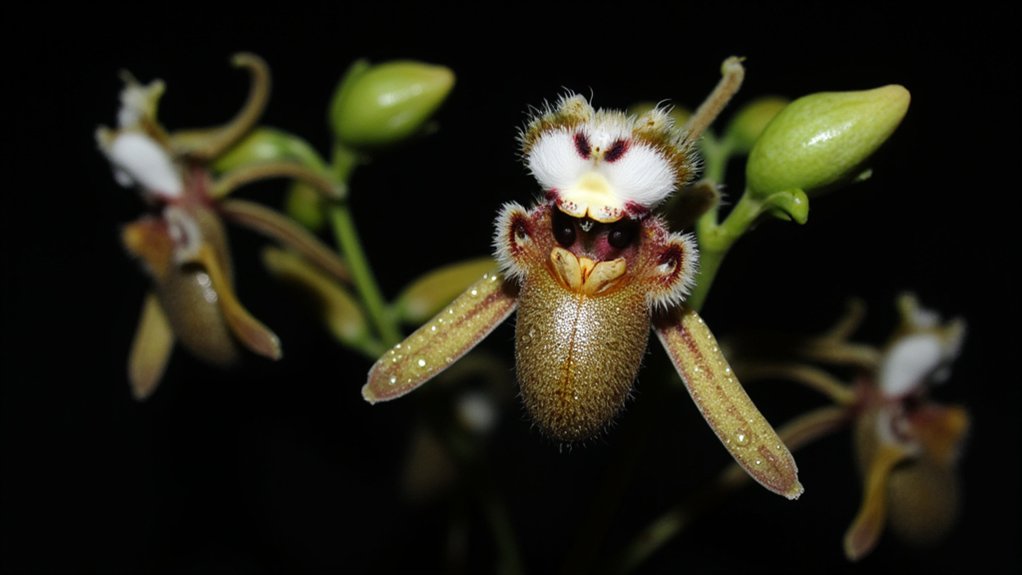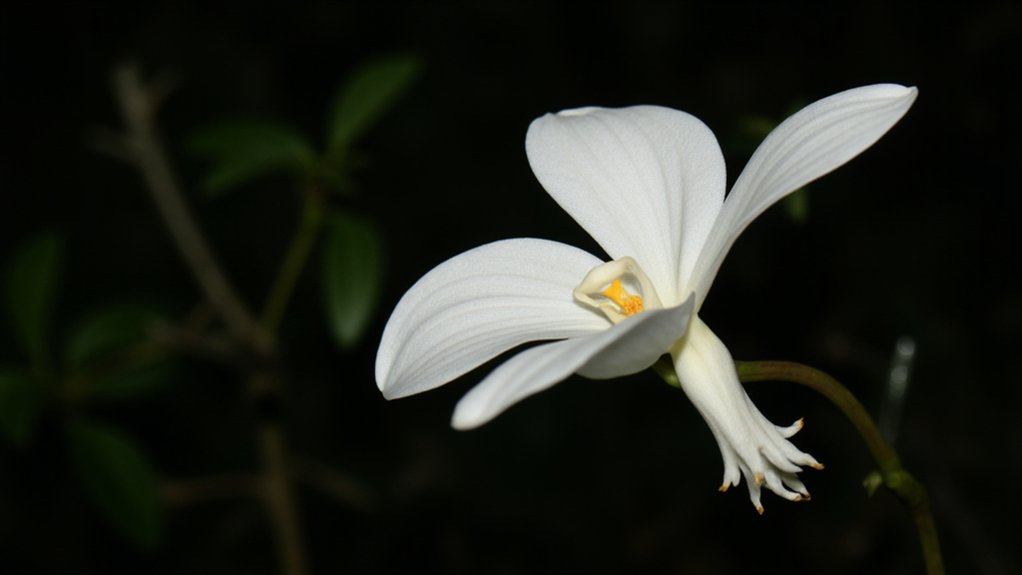You’ll find nature’s most peculiar artistic expressions in the world of mimetic orchids, where flowers have evolved to look remarkably like animals. These botanical masters of disguise don’t just happen by chance – they’re the result of millions of years of evolutionary refinement. From monkey faces to dancing ladies, these rare specimens demonstrate how plants can adapt to attract specific pollinators through visual deception. Let’s explore the extraordinary strategies behind these bizarre blooms.
Contents
- 1 The Fascinating Evolution of Mimicry in Orchids
- 2 Monkey Face Orchid: A Primate’s Perfect Twin
- 3 White Dove Orchid: Wings in Full Flight
- 4 Dancing Lady Orchid: Nature’s Ballerina
- 5 The Bee Orchid’s Remarkable Deception
- 6 Where to Find These Extraordinary Species
- 7 Tips for Growing Animal-Mimicking Orchids
The Fascinating Evolution of Mimicry in Orchids

How did certain orchids develop their uncanny ability to mimic animals? It’s a process that took millions of years through natural selection, as these plants evolved alongside their pollinators. You’ll find that orchids developed their mimicry to attract specific insects needed for reproduction.
When male insects attempt to mate with these convincing flower imposters, they inadvertently transfer pollen between plants. Over countless generations, the orchids that looked most like their target species were more successful at reproduction, leading to increasingly accurate mimicry. This evolutionary arms race has produced some of nature’s most remarkable examples of deceptive adaptation.
Monkey Face Orchid: A Primate’s Perfect Twin

Deep within the cloud forests of Peru and Ecuador, you’ll find one of nature’s most remarkable mimics – the Monkey Face Orchid (Dracula simia). The center of this unique flower features a distinctive arrangement of dark-colored disc florets that create an uncanny resemblance to a tiny monkey’s face, complete with fuzzy eyebrows and a furry beard.
This small orchid, measuring just 2 inches across, blooms throughout the year at elevations between 3,000 and 6,000 feet. You’ll notice its reddish-brown petals frame the monkey-like face, while the scent it produces surprisingly resembles fresh oranges, adding another layer to its peculiar charm.
White Dove Orchid: Wings in Full Flight

The remarkable White Dove Orchid (Peristeria elata) presents one of nature’s most convincing illusions, with inner flower parts that form the shape of a pristine dove in mid-flight. You’ll find this rare species growing naturally in Panama’s tropical forests, where it reaches heights of up to 4 feet.
When you examine the flower closely, you’ll notice how its column, lip, and wings combine to create a detailed dove figure, complete with a distinct head, body, and spread wings. The orchid’s pure white coloring and waxy texture enhance this bird-like appearance, while its blossoms measure roughly 1.5 inches across.
Dancing Lady Orchid: Nature’s Ballerina
Among nature’s most graceful mimics, Dancing Lady Orchids (Oncidium) capture the essence of a twirling ballerina in full motion. You’ll find these delicate blooms displaying bright yellow petals that form a billowing skirt-like shape, while the central column resembles a dancer’s head and torso.
When you look closely at the flower’s structure, you’ll notice it’s actually made up of multiple small blooms, each 1-2 inches wide, arranged on branching spikes that can reach 3-4 feet in length. The plant’s natural movement in light breezes enhances its dance-like appearance, making it a dynamic addition to any orchid collection.
The Bee Orchid’s Remarkable Deception
Perhaps nature’s most cunning trickster, Bee Orchids (Ophrys apifera) have evolved to mimic female bees with extraordinary precision. Their velvety lip features intricate brown and yellow markings that perfectly replicate a female bee’s body patterns, right down to the fuzzy texture.
You’ll find these clever flowers releasing pheromones that match those of female bees, luring male bees who attempt to mate with the blooms. While the males buzz around unsuccessfully, they’re actually helping pollinate the orchids by transferring pollen between plants.
In Mediterranean regions where they grow naturally, you’ll spot these 12-inch tall mimics flowering between April and July.
Where to Find These Extraordinary Species
While many rare orchid species thrive in tropical rainforests, you’ll discover these remarkable animal-mimicking varieties across diverse habitats worldwide. From Mediterranean coastal regions to Australian bushland, these botanical wonders adapt to specific environments.
You’ll find the Monkey Face Orchid (Dracula simia) in cloud forests of southeastern Ecuador and Peru, at elevations between 3,000 and 6,000 feet. The Flying Duck Orchid grows exclusively in eastern and southern Australia, while Italy’s hillsides host the Bee Orchid between April and July.
To spot these elusive blooms, time your visits during peak flowering seasons and connect with local botanical societies for precise locations.
Tips for Growing Animal-Mimicking Orchids
Growing these exotic orchids successfully requires careful attention to their unique environmental needs. You’ll need to maintain humidity levels between 60-80% and temperatures between 65-80°F during the day, with a 10-15°F drop at night.
Plant your orchids in a well-draining mix of fine bark, perlite, and sphagnum moss. Water thoroughly when the medium feels barely damp, typically every 5-7 days. Don’t forget to fertilize weekly with a balanced, water-soluble orchid food at quarter strength.
Position your plants in bright, indirect light, and guarantee good air circulation. Most animal-mimicking species need 4-6 hours of filtered sunlight daily.
